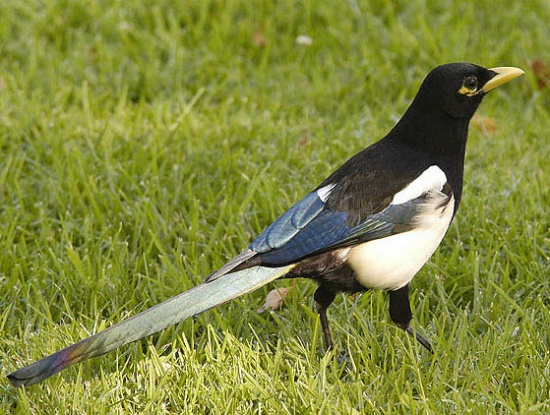m (format) |
|||
| (8 intermediate revisions by 6 users not shown) | |||
| Line 1: | Line 1: | ||
| + | [[Image:Yellow-billed_Magpie.jpg|thumb|550px|right|Photo by {{user|Doug+Greenberg|Doug Greenberg}}<br />Paso Robles, [[California]], [[USA]], October 2004]] | ||
;[[: Category:Pica|Pica]] nuttalli | ;[[: Category:Pica|Pica]] nuttalli | ||
| − | |||
| − | |||
==Identification== | ==Identification== | ||
| − | + | Length 43-54 cm; weight 151-189 g (male), 126-158 g (female)<br /> | |
| − | + | Yellow bill and bare yellow area of skin behind eye. Large white wing patches and long, wedge-shaped, iridescent greenish-black tail.<br /> | |
| + | Juvenile has blackish beak and lacks bare face patch. | ||
| + | ====Similar Species==== | ||
| + | A slightly smaller version of the [[Black-billed Magpie]]. Ranges of the two species do not overlap. | ||
==Distribution== | ==Distribution== | ||
| − | Resident in [[California]] | + | [[Image:Magpie at Mather 073113 01.jpg|thumb|350px|right|Photo by {{user|Phil+Juvet|Phil Juvet}}<br />Sacramento Mather Airport, [[California]], July 2013]] |
| + | Resident in the Central Valley of [[California]] and adjacent foothills.<br /> | ||
| + | A restricted-range species, prior to 2004 locally common or abundant. The West Nile virus has reduced the population by around 50%. | ||
==Taxonomy== | ==Taxonomy== | ||
| − | This is a monotypic species. | + | This is a [[Dictionary_M-S#M|monotypic]] species<sup>[[#References|[1]]]</sup>. |
| + | |||
| + | It is closely related to [[Black-billed Magpie]] and may even be conspecific with the latter. | ||
==Habitat== | ==Habitat== | ||
| − | Oak savannas, oak woods, riverside growth, ranches, and suburbs. | + | Oak savannas, oak woods, riverside growth, ranches, and suburbs. With the loss of natural habitats, they have moved to vacant city weedy yards and lots. |
==Behaviour== | ==Behaviour== | ||
| − | A | + | A strongly colonial species, they live communally throughout the year, feeding, socializing, and mobbing predators. It has become a city bird but avoids heavily populated areas. However, in some places they obviously do not mind people at all. |
| + | ====Diet==== | ||
| + | [[Dictionary_M-O#O|Omnivorous]]. Feeds on insects, mice, bird eggs, nestlings, small reptiles, carrion (especially roadkill) and human handouts. | ||
| + | ====Vocalisation==== | ||
| + | A rising, at times "mag-mag-mag!", or a"quaaa!". Can be heard with a whining "maaag" call. | ||
| + | |||
| + | ====Breeding==== | ||
| + | Breeding season from December to May. They lay 5-8 blotched, olive green eggs in a large, domed stick nest; breeds in colonies in tall trees usually so overgrown with mistletoe that it is often hard to detect the nests. | ||
| − | + | ==References== | |
| + | #{{Ref-Clements6thAug14}}#{{Ref-HBWVol14}}#The website of everything | ||
| + | {{ref}} | ||
| + | https://ebird.org/species/yebmag | ||
| − | |||
==External Links== | ==External Links== | ||
{{GSearch|Pica+nuttalli}} | {{GSearch|Pica+nuttalli}} | ||
| − | [[Category:Birds | + | [[Category:Birds]] [[Category:Pica]] |
Latest revision as of 04:43, 28 March 2025
- Pica nuttalli
Identification
Length 43-54 cm; weight 151-189 g (male), 126-158 g (female)
Yellow bill and bare yellow area of skin behind eye. Large white wing patches and long, wedge-shaped, iridescent greenish-black tail.
Juvenile has blackish beak and lacks bare face patch.
Similar Species
A slightly smaller version of the Black-billed Magpie. Ranges of the two species do not overlap.
Distribution
Resident in the Central Valley of California and adjacent foothills.
A restricted-range species, prior to 2004 locally common or abundant. The West Nile virus has reduced the population by around 50%.
Taxonomy
This is a monotypic species[1].
It is closely related to Black-billed Magpie and may even be conspecific with the latter.
Habitat
Oak savannas, oak woods, riverside growth, ranches, and suburbs. With the loss of natural habitats, they have moved to vacant city weedy yards and lots.
Behaviour
A strongly colonial species, they live communally throughout the year, feeding, socializing, and mobbing predators. It has become a city bird but avoids heavily populated areas. However, in some places they obviously do not mind people at all.
Diet
Omnivorous. Feeds on insects, mice, bird eggs, nestlings, small reptiles, carrion (especially roadkill) and human handouts.
Vocalisation
A rising, at times "mag-mag-mag!", or a"quaaa!". Can be heard with a whining "maaag" call.
Breeding
Breeding season from December to May. They lay 5-8 blotched, olive green eggs in a large, domed stick nest; breeds in colonies in tall trees usually so overgrown with mistletoe that it is often hard to detect the nests.
References
- Clements, J. F., T. S. Schulenberg, M. J. Iliff, D. Roberson, T. A. Fredericks, B. L. Sullivan, and C. L. Wood. 2014. The eBird/Clements checklist of birds of the world: Version 6.9., with updates to August 2014. Downloaded from http://www.birds.cornell.edu/clementschecklist/download/
- Del Hoyo, J, A Elliott, and D Christie, eds. 2009. Handbook of the Birds of the World. Volume 14: Bush-shrikes to Old World Sparrows. Barcelona: Lynx Edicions. ISBN 978-8496553507
- The website of everything
Recommended Citation
- BirdForum Opus contributors. (2025) Yellow-billed Magpie. In: BirdForum, the forum for wild birds and birding. Retrieved 14 May 2025 from https://www.birdforum.net/opus/Yellow-billed_Magpie
https://ebird.org/species/yebmag





